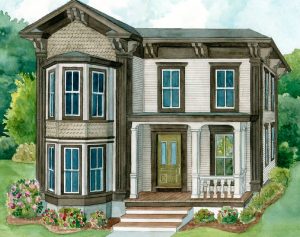 During the Victorian era, British architects developed a style inspired by the villas of Italy. The Italianate style migrated west and became popular in America between 1850 and 1880. The most striking features of Italianate houses are usually its windows and distinctive cornices below low-pitched or flat roofs. Numerous windows – single, paired or even tripled – are typically tall, narrow and elaborately crowned or framed. Cornice lines under wide, overhanging eaves feature large brackets in a wide range of shapes and spacing. Deep trim bands with decorative panels or moldings may further distinguish the cornice line. Single story porches – either full-width, partial-width or surrounding only the entry – often protect double doors that are the same shape as the windows.
During the Victorian era, British architects developed a style inspired by the villas of Italy. The Italianate style migrated west and became popular in America between 1850 and 1880. The most striking features of Italianate houses are usually its windows and distinctive cornices below low-pitched or flat roofs. Numerous windows – single, paired or even tripled – are typically tall, narrow and elaborately crowned or framed. Cornice lines under wide, overhanging eaves feature large brackets in a wide range of shapes and spacing. Deep trim bands with decorative panels or moldings may further distinguish the cornice line. Single story porches – either full-width, partial-width or surrounding only the entry – often protect double doors that are the same shape as the windows.
Profiles:
Italianate houses may feature clapboard, Dutchlap or beaded profiles as the dominant exterior cladding. Not as common, but seen in modern interpretations, is board & batten style. Durable vinyl siding clapboard comes in a variety of configurations including 3″ to 8″ reveals. Beaded is available in 6″ to 7″ reveals. Board & batten style profiles are available in vertical reveals of 6″ to 8″.
Shapes:
Accents for the façade, window bays and/or other portions of the exterior may be achieved with vinyl and other polymeric siding’s distinct shapes. A diverse selection includes scallops, hexagon, octagon, fish scale and half cove.
Color:
Historically, a light to medium palette is used in all colors except reds, greens and browns. Modern interpretations may include darker colors, especially for trim elements. Vinyl siding offers a wide range of colors, including more than 400 colors.
Trim and Accessories:
A wide selection of attractive trim and accessories are available for use with vinyl and other polymeric siding. Options suited for Italianate style include crown and dentil molding for fascia or friezes [or both]; simple to elaborate vertical eave brackets; pedimented window crowns; band boards at foundation or between floors; and beaded soffit.
Customizing Style:
Designers use vinyl and other polymeric siding, trim and accessories to showcase the broad exterior surfaces and decorative accents inspired by the Italianate style. Vinyl siding enables attractive recreations of historic looks, with a modern advantage of virtually carefree durability.
